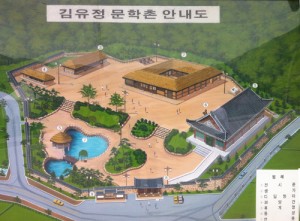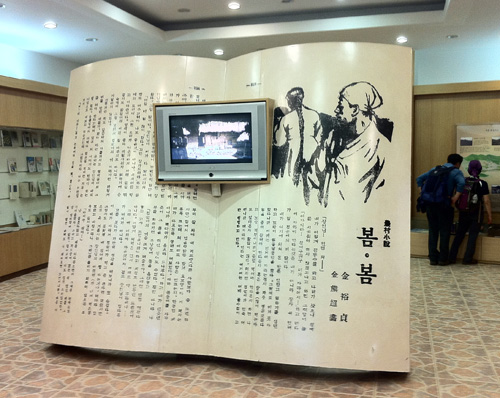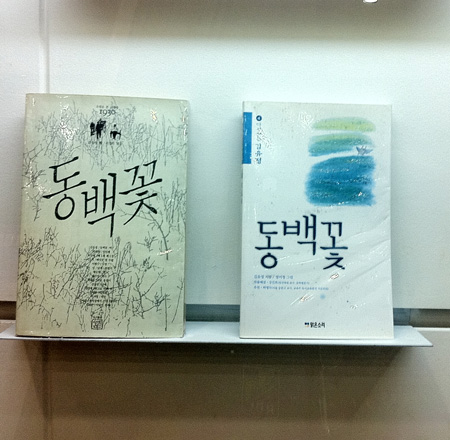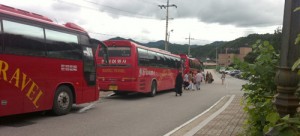The Literary Village of Kim You-jeong, is located in a small village surrounded by mountains, just two subway stations short of Chuncheon. The village is on the new subway line to Chuncheon, which can be picked up at Sangbong station in Seoul. This line makes getting to Chuncheon (and the Kim You-jeong literary site) much easier, but lacks the romance of taking the Mugungwha from Cheongyang-ri to Chuncheon. That train was always packed to the gills with vacationers, normally with plenty of standing tickets sold, and full of students drinking beer and makgeolli in preparation for the fun ahead. The subway is cleaner and runs more often, but a bit more antiseptic.
In any case, it takes just about two hours from Sangbong station, so take a book, preferably one by Kim You-jeong – Pick up the KLTI/Jimoondang Portable Library of Korean Fiction version of Camellias, Scorching Heat, and Wanderer in the Valley, which presents a stunning array of Kim’s powerful work. The collection is named Camellias after its first story and was reviewed on KTLIT here).
Exit the station and follow the signs (one left, one right) and there you are.
The interior of the site is pretty and sometimes features a Kim You-jeong impersonator who speaks no English, but is super-friendly and willing to communicate in gestures and pointing.
On the right side of the compound there is a small, but very nicely appointed museum which has more versions of Camellias than one might think could have been published.^^
There is also a lovely website at http://www.kimyoujeong.org/ but unfortunately for the English-speaker it is Korean only; kind of sad, as there is a quite adequate English-language handout at the museum that would be convenient were it online.
When lakes, fog, dakgalbi (a spicy chicken dish), mime festivals, the pop song “Soyang River Girl,” and the TV mini-series Winter Sonata are mentioned, the city of Chuncheon is the first place that comes to most Koreans’ minds. Chuncheon is also the birthplace of the writer Kim You-jeong (1908-1937), who died prematurely of tuberculosis, leaving behind such classic folk works as Spring ∙ Spring and Dongbaekggot (Yellow Ginger Blossom) . His essay collection, A Mountain Valley in May, published one year before his death, was a dedication to his hometown.
Kim once wrote, “My hometown is in the mountains of Gangwon-do (province). If you go twenty li (eight kilometers) from the town of Chuncheon-eup and follow a winding path through the mountains, you’ll come upon a tiny village. The village is nestled cozily in the middle of steep mountains that surround it on all sides. Buried in the mountains like that, the village looks just like a siru (high-sided rice cake steamer), so it’s called Sille. The homes are mostly old straw-thatched houses on the verge of collapse, and even so, there are less than 50 of them. You could say it’s a very poor hamlet.” (From Chogwang, May 1936)
Kim was the youngest son of a wealthy family in Sille, but having grown up in Seoul, he didn’t get a proper look at Sille until his late twenties. After his love affair with the famous singer Park Rokju ended, Kim withdrew from school and returned to his poor hamlet in despair. His older brother had nearly squandered the family fortune with his prodigal ways. Kim established the private educational institute Geumbyeong-uisuk where he taught the children of Sille, a village that had become impoverished under colonialism, and explored the village’s treasure trove of stories about farm life. He carefully documented the mountains and fields of Sille, people’s speech and mannerisms, and the events that stirred up the town: the 19-year-old wandering prostitute, who ran away from a fake marriage to an old Chongro Intersection bachelor and returned to the village after hiding her ailing husband in a water mill (The Wanderer in the Valleys); Chunho, who made his wife sell her body in order to finance his gambling (The Summer Shower); the farmhand who worked himself to the bone in the hopes of getting married, then got into a big fight with his father-in-law because of his pent-up rage (Spring ∙ Spring); 17-year-old Jeomsun who tempted the tenant farmer’s son into having sex with her on the mountainside where yellow ginger flowers were blooming (Dongbaekggot); Yeongsik who ruined a perfectly good field of beans because he was fooled into thinking there was gold hidden underneath (Picking Gold in a Beanfield); and Mungtae, the biggest bum in the village.
Kim You-jeong, who based his works on these tales whenever he could, returned to Seoul in 1933 and began writing in earnest with the publication of The Wanderer in the Valleys. He also incorporated his stories of scraping by on the outskirts of Seoul, and those of the people around him, onto the page. Of the 30 works that he published until the end of his life, 12 were set in Sille. He devoted himself to preserving a folk style based on the Chuncheon dialect in order to place it on equal footing with the modernity that was the prevailing trend at the time. He told stories of poor farm life, but in the process of writing in order to entertain his readers, Kim You-jeong’s unique literary style was created.







